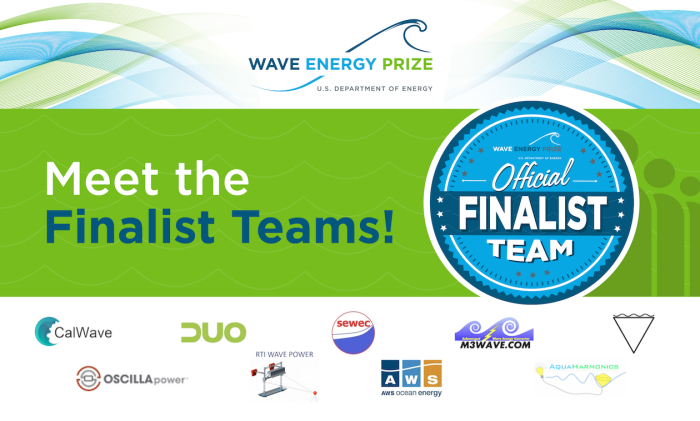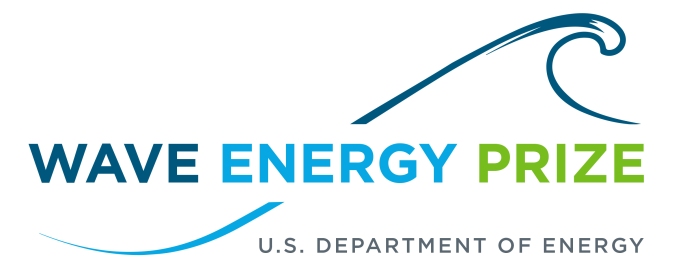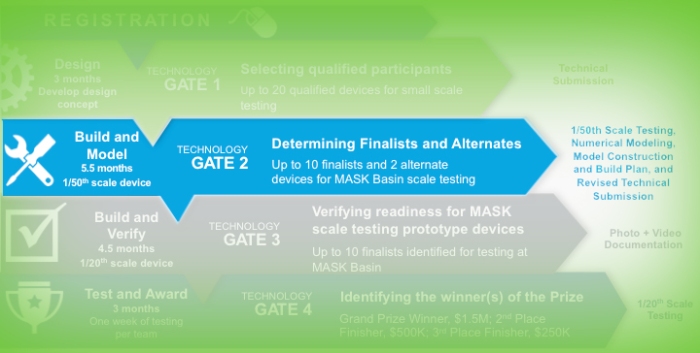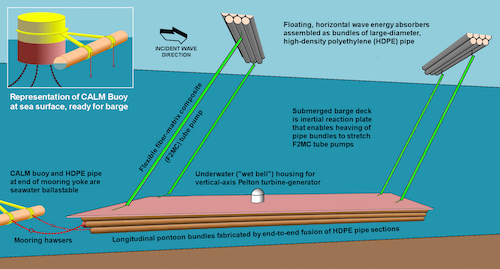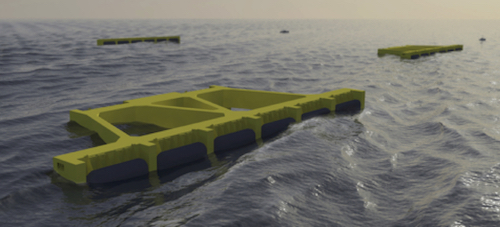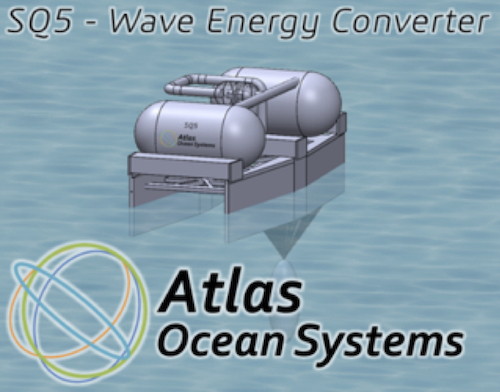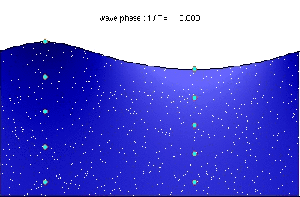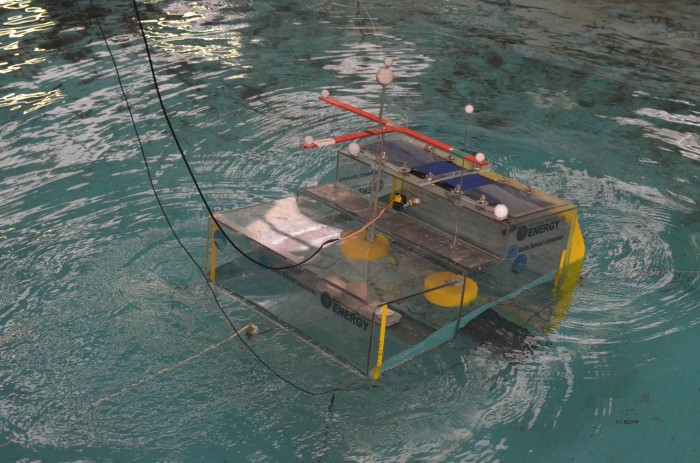
So, how exactly can we exploit this resource?
The Wave Energy Prize received technical submissions detailing 66 unique WEC concepts.
A very small number of these couldn’t work, but the overwhelming majority were concepts that could exploit, to differing degrees, the fluid motions of water particle motions. While some of these concepts were variations on ideas seen before, that is still a very large number of different ideas. At present, the means of exploiting wave power seems only constrained by the imagination of the inventors.
And that is a challenge; one that the Wave Energy Prize is, in part, endeavoring to address.
If one thinks of the development of modern wind turbines 30 to 40 years ago, there was also a plethora of competing wind turbine designs, each hoping to become commercially competitive.
Over time, as the science, engineering and economic understanding has matured, it became possible to identify optimum approaches to the exploitation of the, essentially, linear wind flow into electricity. All turbines now are generally three-blade, horizontal-axis turbines, with a gear box and generator. More modern designs are now using permanent magnet generators, and maybe even novel hydraulic systems. Even then, the principal power absorption mechanism was essentially the same for all wind turbines – linear fluid flow into horizontal mechanical rotation (we do, however, see some small vertical axis turbines in niche applications).
At present, the means of exploiting wave power seems only constrained by the imagination of the inventors.
The same is true of tidal stream turbines, and also aircraft and car designs. Over time, the science and engineering, along with the design tools and test facilities available, lead to a science-backed consensus regarding optimum configurations. Optimum configurations might change as new materials and components become available, but changes are systematically made through an understanding of their impact on a turbine’s techno-economic performance, arising from good knowledge, understanding and information (this can also relate to cars or planes.)
The exploitation of low-speed fluid oscillations created by ocean waves, imparting very high linear or rotational forces/torques, which need to be converted to (generally) high-speed linear or rotational motion in a generator (doing so cheaply and reliably, while being survivable) is just not as well understood within the science community.
Hence the very large number of wave energy conversion concepts we see in the Wave Energy Prize, and throughout the world.
It is possible that there is no single solution that is optimal, or that there are several optimal solutions, dependent on many factors, such as site conditions, water depth, distance to shore, etc.
The exploitation of wave power faces other very significant challenges, perhaps ones that aren’t faced by wind turbines or tidal stream turbines – the most important of these is survival.
Potential wave power sites off the West Coast of the United States have annual average wave energy fluxes in the region of 20-30 kWm-1 of wave crest length. In severe winter storms, the peak power can be multiple times higher than this, perhaps as high as 1MWm-1 (an increase by a factor of 30-50 over the average wave energy flux). This provides significant challenges to the structural design and consequent capital cost, or requires survival strategies, such as diving, submersion, or perhaps even removal to shore. And these typical winter storms are not as strong as the survival conditions to be met for the “100 year wave” or rogue waves, which will be even more demanding.
Wind turbines operate in a relatively narrow range of wind speeds, and simple survival strategies are possible when winds exceed operational limits; they feather their blades to minimize the forces on the turbine. Furthermore, the forces imparted by water with a density of ~1000kgm-3 are so much larger than when the fluid is air. Tidal stream turbines are also frequently not exposed to the severe storm conditions or wave energy potentially encountered by WECs. Besides, the environmental conditions seen are far more predictable and the ranges are not so extreme.
Interestingly, deep-water waves are also intrinsically more survivable than near-shore ones, as near-shore devices could well be exposed to severe breaking waves in harsh storm conditions, which would likely lead to catastrophic failure. In severe storms, big ships head away from the shore and out to deep water for the same reason.
The exploitation of wave power also creates other challenges that are not normally as onerous for wind turbines and tidal stream turbines. These include:
- This is straightforward for onshore and relatively straightforward for shallow-water offshore wind turbines. Tidal stream is more challenging, due to the high-speed water currents in commercial sites, but still relatively close to shore, and not at very significant water depths. For WECs in deep water, this requires multiple mooring systems, potentially remotely operated vehicles and divers, possibly operating many miles from the shore base for marine operations.
- This requires access in potentially hostile and dangerous environments, with weather window constraints.
- Some WEC concepts are intrinsically directional in their approach to exploiting wave power, whereas wind turbines and potentially tidal stream turbines have easy strategies for orienting the system towards optimum flow conditions for energy extraction.
- Marine debris and biofouling. With many wave energy concepts located at the surface of the sea where the wave energy is greatest, they are potentially more vulnerable to damage caused by marine debris, such as shipping containers, ropes and fishing nets. Biofouling is also far more prevalent at the surface or near the surface, as this is where the biological activity is greatest.
- Other uses of the sea. WECs potentially have greater impacts on other users of the sea, such as those in shipping, fishing and recreation. Many wave energy concepts have some freedom to move, but tidal or wind turbines are essentially static devices that are constrained by moorings. This uses up a large surface of the sea, and increases the potential for collisions.
- Non-linearity. Wave energy theory is linear, which is an approximation that holds only for small waves. In practice, the waves themselves and the interaction of the device with them is likely to be non-linear, potentially requiring very significant computer power to even understand how the device might react to the waves, or accepting uncertainty in performance and maybe life-time of the device.
- Breaking waves. This is not really a great concern for deep-water WECs, with the possible exception of rogue waves or in survival conditions. However, breaking waves impart huge slamming forces on structures and their moorings, leading to potentially catastrophic failure.
All in all, a very difficult environment to design for and survive in.
Whatever the solution is that emerges from the Wave Energy Prize and other U.S.-based and global development activities, to be successful we need to see large increases in the absorbed power, with high bandwidth and adaptability to different sea states, and maybe even wave-to-wave control, with greatly reduced capital expenditure, reliability, survivability, and maintainability.

